Pipe cutter for steel pipes: types, tips for selecting a model and nuances of proper operation
Carrying out various communication, construction and repair and installation works involves cutting steel pipes into fragments of the required sizes.To do this, you can use a simple tool at home, for example, a hacksaw.
But it is smarter and more practical to purchase a pipe cutter for steel pipes. This unit will speed up the process and make it much less complex and labor-intensive. Let's look at the varieties of this tool, the principles of its operation, as well as the features of choosing equipment.
The content of the article:
- Classification of pipe cutters by type of drive
- Types of separating elements
- Design features of the clamping unit
- How to choose a blade for a tool?
- How manual models work
- What types of electric pipe cutters are there?
- Preparing and cutting steel pipes
- Rules of operation and care
- Conclusions and useful video on the topic
Classification of pipe cutters by type of drive
Modern models of pipe cutters, designed for cutting steel pipes of various diameters, differ in the type of drive.
Manual the tools are considered the simplest and do not require special skills to use. Usually they are simply fixed in the processing area, made several turns and a fragment with a clear cut is obtained. However, this option requires the use of significant physical effort and is not suitable for large-scale work.

Electrical the units are made from stronger, wear-resistant materials, so they are suitable for active use, easily cope with intense loads and can efficiently cut steel pipes of any diameter, including large ones.

Pneumatic Pipe cutters are professional equipment. They provide high precision processing and quickly make the necessary cut.
They cut pipes of any thickness (from thin-walled to 60 mm). They allow you to carry out the necessary work in a small room and have the function of boring the inner diameter of the pipe for subsequent welding.
They have high power and can easily cope with increased industrial loads.
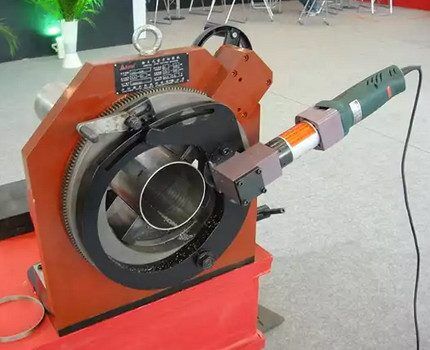
Hydraulic Pipe cutters do not require connection to an electrical network, and operate using the principle of liquid pressure. Pumped through the pump, it acts on the piston and puts the unit into action. When the water pressure decreases, the cutting elements return to their original position.
Tools of this class are more powerful than manual ones, but they are inferior to electric devices in all respects.
The choice of unit, first of all, depends on the amount of work that is planned to be performed. For a one-time use, a simple hand tool will suffice, but for large-scale events (such as laying communications on a personal property), it is better to use an electric option.
If there is no way to connect to the network, you will have to consider purchasing or renting a hydraulic pipe cutter for household purposes. In industry, it is most productive to use pneumatic machines for cutting steel pipes.
Types of separating elements
Units designed for cutting steel pipes of different diameters, differ from each other by the type of element performing the trimming.
Roller the tools consist of 1-4 cutting and several feed rollers. A model with one drive roller allows you to process a steel pipe with a diameter of up to 50 millimeters, and a three-roller model can easily handle a part with a cross-section of up to 100 millimeters.
However, it is extremely rare to obtain a perfect cut without roughness from roller units, and this point is considered the main disadvantage of the equipment.

Incisive The devices are an iron cage that covers the workpiece. The high quality and durable material of the working element allows the tool to be used for cutting thin steel pipes. The position of the cutters is additionally adjusted depending on the thickness of the metal and the overall diameter of the pipe. The moving part of the unit is moved by a threaded rod.
Simple models are equipped with only two cutters, and the rod element also serves as a handle. These tools are suitable for processing metal up to 1 inch thick.
For pipe material with thicker walls, you will need to buy special cutters. The main advantage of the units is the ability to obtain a perfectly smooth cut that does not require subsequent countersinking.
Chain The modules are similar in principle to a chain saw. They have a tensioning mechanism, swing arms and chains with rollers. With a tool of this type, you can effortlessly cut single-layer pipe material with a cross-section of up to 3 centimeters.
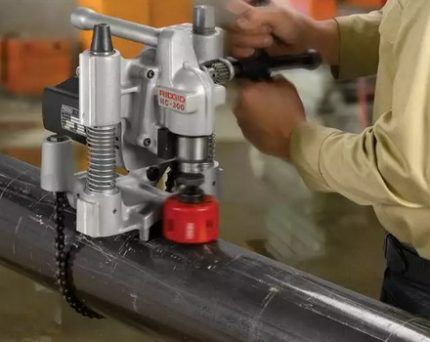
Turning The pipe cutter operates through identical interchangeable rollers that are securely fixed around the product. The unit is driven by a removable handle, and the working elements reliably and accurately carry out the cut.
The main advantages of the device include:
- the ability to quickly cut pipe structures with a wall thickness of up to 19 millimeters;
- effective work in difficult conditions (underwater, at the bottom of trenches, in pits, etc.).
Of the shortcomings, only one stands out - the high cost of the device, but in industrial production it quickly pays off. Therefore, price does not become a stumbling block for owners of large enterprises engaged in commercial repair, installation, communications and construction activities.
You should purchase a suitable pipe cutter taking into account the size of the pipe you will have to cut, where exactly the work will be done and how important it is to immediately obtain a smooth, neat cut that does not require further finishing.
Design features of the clamping unit
Another important distinguishing feature of units designed for convenient cutting of steel pipe material is the design of the clamping unit. It can be clamp, lever and screw.
Manual clamping or “locking” devices operate quickly and cleanly, easily withstand heavy operating loads and handle pipes up to 12 inches thick and up to 324 mm in diameter.
They have one long handle and one auxiliary one. Thanks to this design, the operator does not have to use excessive force for cutting, and the equipment is adjusted directly during operation.
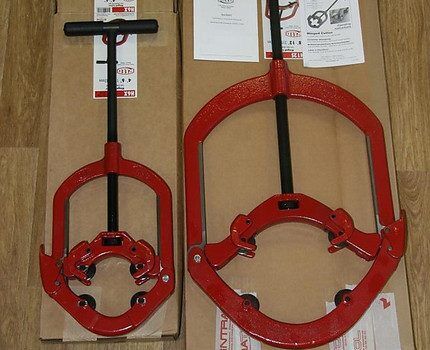
A huge advantage of the equipment is that a full rotation of the device around the part is not required, so cutting the material can be carried out in cramped conditions, limited spaces, and even using the rolling method.
In lever models, the part is fixed by pressing the lever, while in screw models it is held in a constant position by reliable and strong screw elements. To prevent the pipe walls from being crushed during processing, the part is clamped medium-strongly and held in this position until the moment of cutting off.
How to choose a blade for a tool?
For steel pipe cutters, some specific features relate, in particular, to the working blades of the tool. To perform a high-quality cut, they must have a hardness that is 15...20 HRC higher than the hardness of the pipe material being processed.
This parameter can be determined by performing the so-called “spark test”. It will reveal the approximate percentage of carbon and make it possible to identify molybdenum, tungsten and manganese. In this way, it will become clear what the initial hardness is and what grade of steel was used to make the pipe.
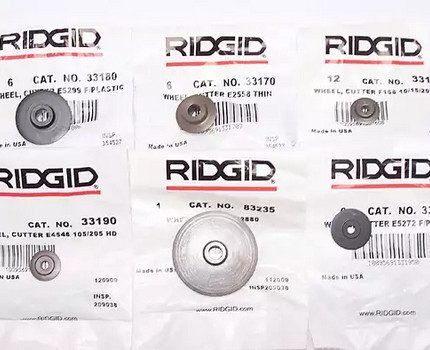
To carry out the test, the end part of the part is processed on an emery grinder and the spark generated in the process is carefully examined:
- a more continuous sparkling beam of light yellow color means low-carbon non-alloy steel;
- a medium-carbon composition is indicated by a beam of the same color, but more branched, with a certain number of bright flashes;
- standard quality steel produces a thin spark stream with short branches and an almost complete absence of flashes;
- alloy steel is characterized by increased strength and does not show a tendency to brittle fracture. The stream of sparks shines with a thick and rich yellow color, and instead of light flashes, elongated shiny arrows are observed.
Having detailed information about the quality of the steel from which the pipe requiring processing is made, choosing the appropriate cutting equipment will be easy and quick.
How manual models work
In everyday life, cutting steel pipes is most easily done with a roller pipe cutter. This tool has several circular knives and can easily handle material with a diameter of up to 100 millimeters.
For long pipes there are special devices equipped with not only cutting, but also guide rollers. This allows you to clearly fix a part of any size and ensures its longitudinal stability during processing.
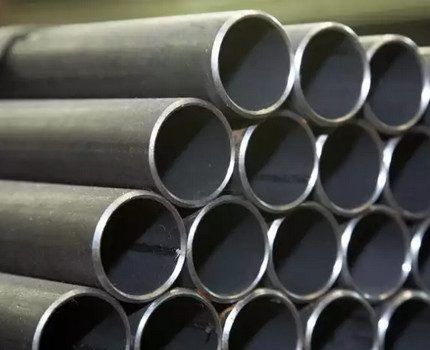
It is advisable to cut large-diameter pipes (150-200 mm) with a rotary unit equipped with a telescopic mechanism responsible for turning the cutting rollers.
These designs provide the opportunity to process parts in unfavorable conditions (pits, excavations, trenches, etc.).
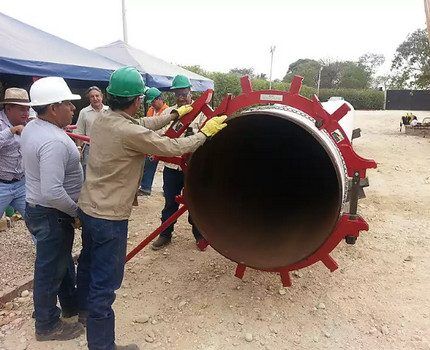
In a rotary device, rollers are attached along the outer perimeter of the pipe. When acting on a lever equipped with a mechanical amplifier, they are pressed to the surface of the workpiece.
Additional movements increase the feed and gradual separation occurs. The cutting is carried out not so much by force as by the developed torque. The technology provides a clean, smooth cutting edge when working with even tougher alloy steels.
What types of electric pipe cutters are there?
When you plan to lay a large-scale communication system or carry out global repair and installation work, it makes sense to abandon hand tools and give preference to an electric unit.
It functions perfectly both in stationary and field conditions and makes it possible to perform processing as quickly and cleanly as possible.
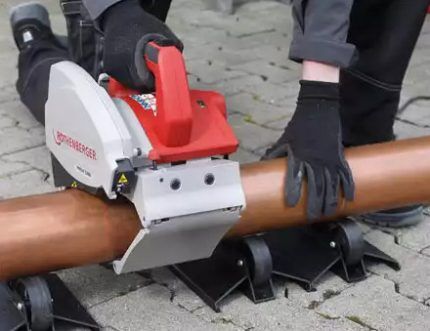
According to the type of design, electric pipe cutters are either one-piece or detachable. One-piece units are located on the outer surface of the part and are fixed using a self-centering clamp.
They have compact dimensions and do not require a large space around the pipe to carry out full processing.

Split machines for cutting steel pipe material are easily attached to any part of the part. The device consists of interchangeable modules and is placed on the outer part of the surface.
Despite the fact that the working elements occupy minimal space around the pipe, the cut when cutting is very accurate and does not require additional processing.

The cutting element in the device is a pair of cutters with a step stroke of 0.01 cm. The operation of the tool is activated by an electric motor powered by a 220 V network.
Thanks to the high-strength split housing, consisting of two parts, the unit can be installed on an already functioning pipeline and quickly eliminate a sudden breakdown or carry out the necessary maintenance of any complexity.
To increase the processing speed, one of the cutters is attached to the edge of the pipe, and the second one cuts a chamfer during the process. The device is fixed with special cams. Usually there are from 4 to 8 pieces.
For complete control of all processes, the device is equipped with a servo drive. It makes it possible to closely monitor the torque and timely adjust the speed of cuts.
Preparing and cutting steel pipes
Before you begin cutting, the pipe material must be properly prepared:
- Moisten the area of intended separation with oil.This will reduce the temperature of the metal during operation, clean the outer perimeter and partially remove scale.
- Using a clamp, secure the pipe in the holder, focusing on the cut line previously marked with a marker.
- Using the rod, move the cutting head around the perimeter of the part. Gradually increase the feed, making the required cut.
- If the knives have the necessary strength and a good level of sharpening, the cutting area will be smooth and will not require further processing.
In models designed for cutting small diameter pipes (no more than 30 mm), the rod is combined with the handle. When it is set in motion, the cutting itself occurs.
Cutting small diameter pipes
To cut small-diameter steel pipe material, the part to be processed is clearly secured with the clamping mechanism of the pipe cutter. The tool handle is turned clockwise so that the cutting element comes into contact with the metal surface.
Then they make another turn of the handle, making sure that the beginning and end of the cut line are in contact, creating a clear closed circle without interruptions or other violations.
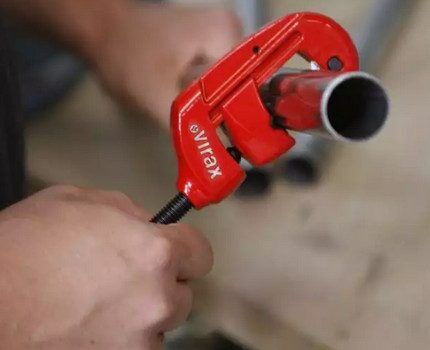
If these parameters are met, the tool handle is moved another half turn, pulling the cutting element closer to the pipe. When the cutters clearly enter the metal, the scrolling is accelerated a little and the handle is rotated until cutting occurs.
Cutting large diameter steel pipes
In everyday life, cutting large-diameter steel pipes is practically not in demand.Basically, material of such dimensions is processed on an industrial scale. For this purpose, enterprises buy very powerful, expensive equipment.
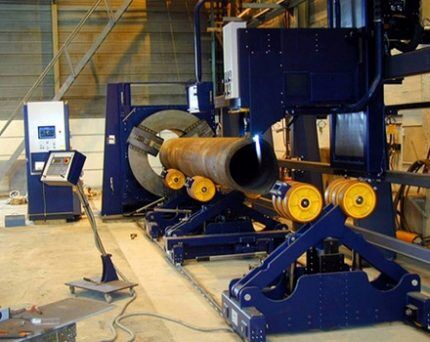
If, nevertheless, the need suddenly arises for cutting large-diameter pipes, it is not necessary to purchase professional equipment.
You can use an ordinary grinder, which is available in the arsenal of every owner, and, by installing a cutting element for metal on it, make a quick, accurate and high-quality cut. But when working with this tool, one should not forget about precautions.
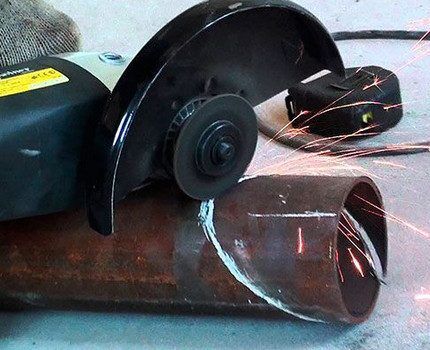
But nevertheless, the grinder is only suitable for one-time cutting and cutting work. For regular large-scale events, it makes sense to acquire a more durable and powerful unit.
You can read more about the different types of pipe cutting equipment in this material.
Rules of operation and care
In order for the pipe cutter to serve for a long time and reliably, to perform high-quality cutting and not to damage the pipe walls during operation, it is very important to choose the optimal level of clamping of the steel part.
Do not over-tighten the workpiece.This can cause a discrepancy between the beginning and end of the cut line, creating an unaesthetic appearance of a screw thread on the part.
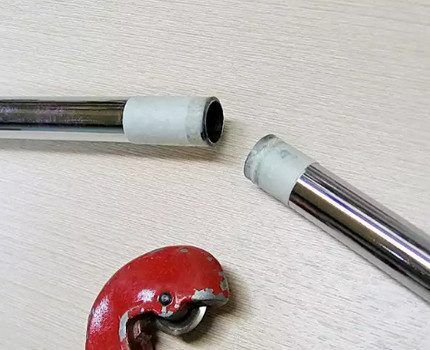
The rotation of the mechanism should be carried out evenly, but not very quickly. Otherwise, the walls will collapse and excess cut metal will form at the cut-off point.
For correct and long service after work, the surface of the cutting roller, feed screw and guide rollers are cleaned with a special product and then treated with lubricant.
The outer surface is inspected for dents or other damage, and chips are sanded so that they do not interfere with subsequent work. The cutting elements (cutter or roller) are inspected for dullness and, if necessary, immediately replaced.
For storage, the pipe cutter is left in a dry and warm place. After such procedures and comfortable storage conditions, the device will remain operational for a long time and will easily cope with all tasks.
Conclusions and useful video on the topic
How a pipe clamp cutter works: detailed video instructions on how to use a manual pipe cutter equipped with a clamp latch. The reliable unit has good power and copes with parts with a diameter from 32 to 365 mm.
Cutting steel pipes with a roller pipe cutter: the video clearly shows the process of cutting steel pipe material with a diameter of 3 to 150 mm with a roller unit.
The manual model copes well with one-time work, while the electric model is suitable for larger repair and installation projects.
A split pipe cutter for steel in operation: how a split cutting device works with steel pipes can be clearly seen in this video. The device has a useful function that allows partial cutting of the pipeline even without access to the end part of the system.
The device is equipped with an electric or pneumatic drive and provides maximum cutting accuracy while using a minimum space around the pipe for work.
Knowing all the nuances described above, choose the optimal pipe cutter model it won't be difficult. For additional advice before purchasing, you should contact the store staff. They will talk in detail about the models offered and describe all the pros and cons of products from various brands.
Looking for a pipe cutter for home use? Or do you have experience using such devices? Share it with our readers. Please tell us which model you chose, are you satisfied with your purchase? Write comments under the article.



